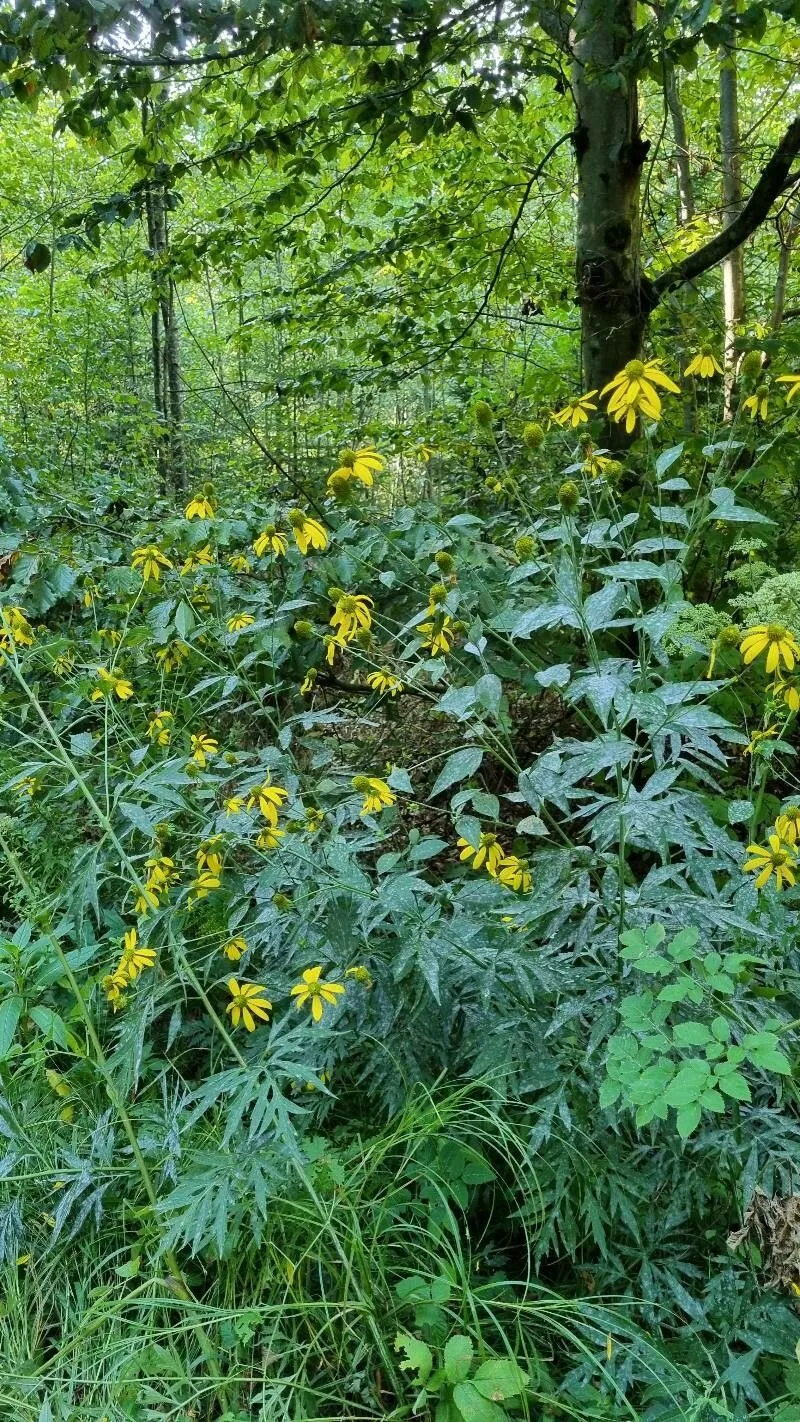
Author: L.
Bibliography: Sp. Pl.: 906 (1753)
Year: 1753
Status: accepted
Rank: species
Genus: Rudbeckia
Vegetable: False
Observations: C. & E. Canada to C. & E. U.S.A.
The Tall Coneflower, scientifically known as Rudbeckia laciniata, is a perennial herbaceous plant that belongs to the family Asteraceae. Described by the renowned botanist Carl Linnaeus in his landmark publication “Species Plantarum” in 1753, this plant has since become well-known and appreciated for its striking appearance and ecological value.
This robust and towering plant is native to North America, specifically thriving from Central and Eastern Canada through to Central and Eastern United States. It is commonly found in a variety of habitats including moist meadows, prairies, and along stream banks where it can take advantage of the rich, damp soil.
The Tall Coneflower is characterized by its impressive height, often reaching up to six feet or more. Its stems are sturdy and can support the large, yellow flower heads that are a signature feature of this species. The flowers, which bloom from mid-summer to early fall, consist of drooping yellow ray florets that encircle a prominent, greenish to brownish central cone, giving them a distinct and eye-catching appearance.
The leaves of Rudbeckia laciniata are deeply cut into lobes, which is reflected in its species name “laciniata”, meaning “torn” or “lacerated” in Latin. These leaves are arranged alternately along the stem and add to the plant’s lush, full foliage.
In addition to its aesthetic appeal in gardens and wildflower meadows, the Tall Coneflower plays an integral role in its ecosystem. It provides nectar and pollen for a variety of pollinators including bees and butterflies, and its seeds offer nourishment for birds and other wildlife as the season transitions to fall.
Despite its beauty and ecological importance, the Tall Coneflower can sometimes become invasive in certain areas if not managed properly. Gardeners who choose to cultivate this plant should be mindful of its growth tendencies and ensure it is planted in appropriate conditions where it can be maintained.
Overall, the Tall Coneflower, Rudbeckia laciniata, remains a cherished addition to both natural landscapes and cultivated gardens. Its tall stature, vibrant flowers, and ecological benefits make it a plant of significant interest and importance in the regions where it naturally occurs.
Dan: almindelig rajgræs, fliget solhat, italiensk rajgræs, kæmpe-solhat, rørgræs, solhat
Eng: coneflower, cut-leaf coneflower, cutleaf coneflower, tall cone flower, tall coneflower, cut-leaved coneflower, cone-flower, green-headed coneflower
Swe: engelskt rajgräs, italienskt rajgräs, rörflen, sandbrodd, höstrudbeckia, syyspäivänhattu
Fin: englanninraiheinä, italianraiheinä, ruokohelpi, syyspäivänhattu
Nor: italiensk raigras, raigras, strandrøyr
Lit: plunksnalapė rudbekija
Fra: rudbeckia, rudbeckie découpée, rudbeckie laciniée, rudbéckie laciniée, rudbeckia lacinié
Ita: rudbeckia comune
Pol: rudbeckia naga
Deu: schlitzblatt-sonnenhut, schlitzblättriger sonnenhut
Nld: slipbladige rudbeckia
Isl: túnrúggresi
Nob: gjerdesolhatt
Nno: gjerdesolhatt
Est: lõhislehine päevakübar
Hun: magas kúpvirág
Ces: třapatka dřípatá
Cym: blodau pigwrn, blodyn pigwrn, cônlys
Lat: rudbeckia
En: Tall coneflower, Cut-leaf coneflower, Coneflower, Cutleaf coneflower, Sochan, Wild goldenglow, Green-Head Coneflower, Golden glow. thimbleweed, Greenheaded coneflower, Tall cone flower, Cut-leaved coneflower, Cone-flower, Green-headed coneflower
Be: Рудбекія рассечаная
Zh: 金光菊
Cs: Třapatka dřípatá
Da: Almindelig Rajgræs, Fliget solhat, Italiensk Rajgræs, Kæmpe-solhat, Rørgræs, Solhat
Nl: Slipbladige rudbeckia
Et: Lõhislehine päevakübar
Fi: Syyspäivänhattu, Kultapallo, Kultapäivänhattu, Englanninraiheinä, Italianraiheinä, Ruokohelpi
Fr: Rudbeckia lacinié, Rudbeckia, Rudbeckie découpée, Rudbeckie laciniée, Rudbéckie laciniée
De: Schlitzblättriger Sonnenhut, Schlitzblatt-Rudbeckie, Wesenitzblume, Schlitzblatt-Sonnenhut
Hu: Magas kúpvirág
Is: Túnrúggresi
It: Rudbeckia comune
Ko: 삼잎국화
La: Rudbeckia
Lt: Plunksnalapė rudbekija
Nv: Sílátsoh
No: Gjerdesolhatt, Italiensk raigras, Raigras, Strandrøyr
Nb: Gjerdesolhatt
Nn: Gjerdesolhatt
Fa: کوکب کوهی برگبریده
Pl: Rudbekia naga, Rudbeckia naga
Sk: Rudbekia strapatá
Sv: Höstrudbeckia, Engelskt rajgräs, Italienskt rajgräs, Rörflen, Sandbrodd, Syyspäivänhattu
Zh-tw: 金光菊
Zh-hant: 金光菊
Cy: Blodyn pigwrn, Blodau Pigwrn, Cônlys
Taken Oct 2, 2021 by Jani Zadrgal (cc-by-sa)
Taken Aug 19, 2020 by Dieter Wagner (cc-by-sa)
Taken Sep 7, 2021 by Löffelmann Charlotte (cc-by-sa)
Taken Aug 30, 2017 by chriselis (cc-by-sa)
Taken Sep 3, 2021 by Josef Wanas (cc-by-sa)
Taken Jun 28, 2021 by Boumlik Messaïli (cc-by-sa)
Taken Aug 17, 2022 by Jani Zadrgal (cc-by-sa)
Taken Jul 20, 2022 by Fabrice Rubio (cc-by-sa)
Taken Jul 12, 2022 by Fabrice Rubio (cc-by-sa)
Taken Jun 24, 2021 by France Loiselle (cc-by-sa)
Taken Aug 17, 2022 by Jani Zadrgal (cc-by-sa)
Taken Jun 24, 2021 by France Loiselle (cc-by-sa)
Taken Sep 7, 2020 by Jason Roberts (cc-by-sa)
Taken Jul 20, 2022 by Fabrice Rubio (cc-by-sa)
Taken Oct 2, 2021 by Jani Zadrgal (cc-by-sa)
© copyright of the Board of Trustees of the Royal Botanic Gardens, Kew.
© copyright of the Board of Trustees of the Royal Botanic Gardens, Kew.
© copyright of the Board of Trustees of the Royal Botanic Gardens, Kew.
Taken Sep 27, 2022 by wildpatch (cc-by-sa)
Taken Dec 8, 2021 by Dutch Flowers (cc-by-sa)
Taken Aug 29, 2020 by Moritz Reichard (cc-by-sa)
Taken Nov 20, 2013 by EOL − Daniel Carter (cc-by-nc)
Taken Oct 2, 2021 by Jani Zadrgal (cc-by-sa)
Taken Apr 19, 2022 by Hill Paige (cc-by-sa)
Taken Aug 30, 2020 by Nicolas Tison (cc-by-sa)
Taken Aug 17, 2019 by Fedan Hacizade (cc-by-sa)
Taken Jul 15, 2021 by Sabin Poenariu (cc-by-sa)
Taken Jul 12, 2021 by Sabin Poenariu (cc-by-sa)
Taken Oct 15, 2015 by Photoflora – Benoit BOCK (©)
Taken Oct 15, 2015 by Photoflora – Benoit BOCK (©)
Taken Oct 15, 2015 by Photoflora – Benoit BOCK (©)
Taken Aug 17, 2019 by Fedan Hacizade (cc-by-sa)
Taken Aug 1, 2022 by Radu Nicolau (cc-by-sa)
Growth form: Rhizomatous
Growth habit: Subshrub, Forb/herb
Growth rate: Rapid
Ph maximum: 7.0
Ph minimum: 4.5
Light: 8
Atmospheric humidity: 7
Soil nutriments: 7
Family: Myrtaceae Author: (F.Muell.) K.D.Hill & L.A.S.Johnson Bibliography: Telopea 6: 402 (1995) Year: 1995 Status:…
Family: Rubiaceae Author: Pierre ex A.Froehner Bibliography: Notizbl. Bot. Gart. Berlin-Dahlem 1: 237 (1897) Year:…
Family: Sapindaceae Author: Koidz. Bibliography: J. Coll. Sci. Imp. Univ. Tokyo 32(1): 38 (1911) Year:…
Family: Asteraceae Author: A.Gray Bibliography: Pacif. Railr. Rep.: 107 (1857) Year: 1857 Status: accepted Rank:…
Family: Fabaceae Author: Medik. Bibliography: Vorles. Churpfälz. Phys.-Ökon. Ges. 2: 398 (1787) Year: 1787 Status:…
Family: Aspleniaceae Author: (Cav.) Alston Bibliography: Bull. Misc. Inform. Kew 1932: 309 (1932) Year: 1932…